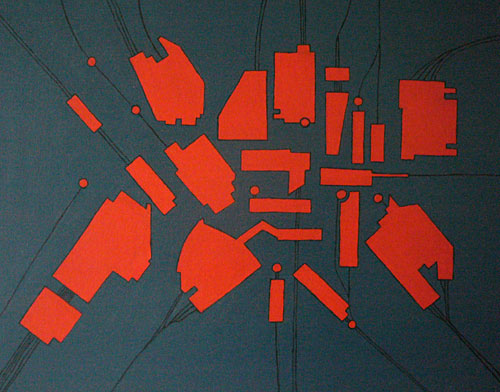The Frightened Stations Gathered Together for Mutual Support
The Frightened Stations Gathered Together for Mutual Support - acrylic on canvas (2002) ‘A complex kind of joy’It is perhaps not surprising that artists who have been through something of the grimness of the asylum experience for themselves may feel that humour offers one way out of an inherently dehumanising situation. Edita Pecotic, an artist from Croatia now living in London, demonstrated a light touch in Frightened Stations Gathered Together for Mutual Support, a work reflecting the changing social nature of the urban railway stations where immigrants now arrive in western cities. The station was once the iconic symbol of modernity but Pecotic subverts its meaning from an expression of confidence and faith in a rational, cosmopolitan and fast-moving modern world, by introducing fear into the picture. Described as the nineteenth century’s “true cathedrals” and established by artists such as Monet and Caillebotte as emblematic of the progress brought on by manufacturing and the growth of metropolitan life, stations no longer represent such unproblematic and optimistic attitudes. For many people, they now symbolise uncertain arrivals and departures; they are places to be fearful and tentative, sites of anxiety and apprehension where a welcome may be far from forthcoming. No wonder they have become ‘frightened’ and need to ‘huddle together for mutual support.’ Nonetheless, there is something playful about the work which brings to mind the comment made by Breda Beban, artist and curator from the former Yugoslavia of the Imaginary Balkans exhibition. “Most of the work in the exhibition is about tracking down a sense of joy,” she reflected, but this is the kind of joy informed by sadness, a complex kind of joy.” (Alex Rotas, 2003) Edita Pecotic has always been interested in the political issues of otherness, both while living in Croatia and here in the UK. The experiences of alienation and insecurity are conveyed in her work mainly by addressing the urban environment, both its beauty and banality. The landscapes she depicts represent atmospheres of desertion and implicate feelings of fear and loneliness. However, in her work she also tries to move away from a feeling of entrapment by appreciating and expressing the distinctiveness and beauty of these settings, as part of negotiating a new feeling of belonging. She emphases the sense of the 'bright side' by aspiring to introduce humor to her work. |
